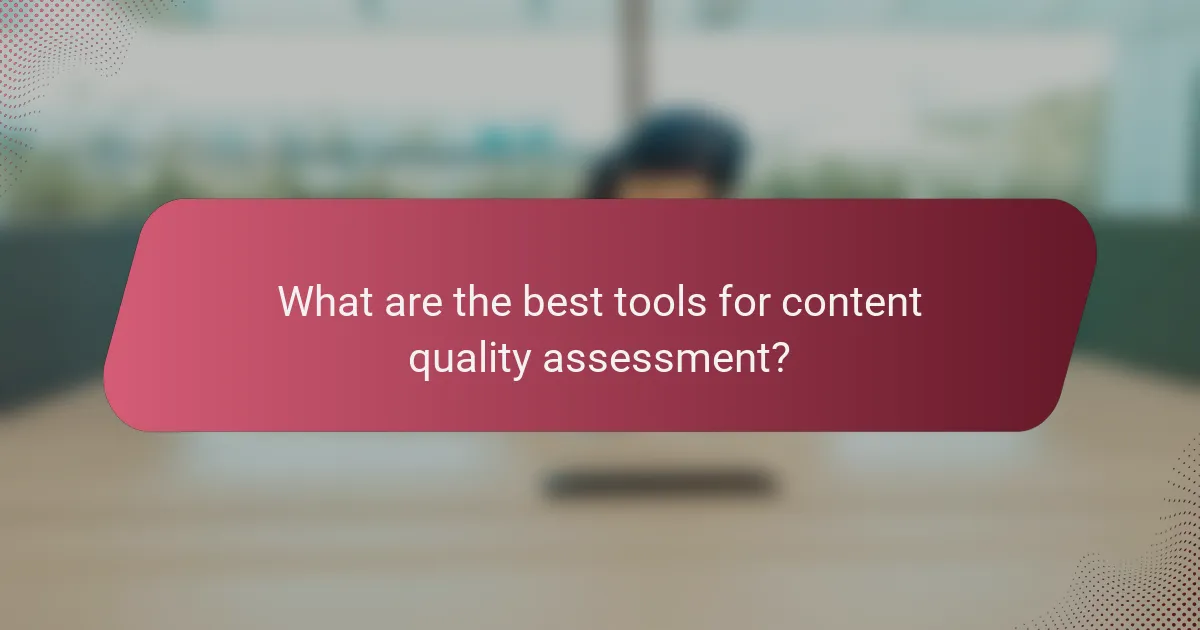In B2B marketing, assessing content quality is crucial for determining how effectively it meets business objectives. By focusing on performance indicators, engagement levels, and audience feedback, marketers can gain valuable insights into their content strategy. To enhance content quality, businesses should implement strategic planning, conduct regular assessments, and utilize targeted optimizations tailored to their audience’s needs.

How to assess content quality in B2B marketing campaigns?
Assessing content quality in B2B marketing campaigns involves evaluating various metrics that reflect how well the content meets its objectives. Key areas of focus include performance indicators, engagement levels, conversion rates, and audience feedback, all of which provide insights into the effectiveness of the content strategy.
Key performance indicators (KPIs)
Key performance indicators (KPIs) are essential for measuring the success of B2B marketing content. Common KPIs include website traffic, lead generation, and social media shares, which help gauge how well the content attracts and retains an audience. Aim for a balanced mix of quantitative and qualitative KPIs to get a comprehensive view of performance.
For instance, a good starting point is to track website traffic growth of 10-20% month-over-month, while also monitoring the number of leads generated from specific content pieces. This dual approach allows for a clearer understanding of both reach and impact.
Content engagement metrics
Content engagement metrics provide insights into how users interact with your B2B content. Metrics such as time spent on page, scroll depth, and bounce rates are crucial for understanding audience interest and retention. High engagement often indicates that the content resonates with the target audience.
For example, if users spend an average of 3-5 minutes on a whitepaper page, it suggests that the content is valuable. Conversely, a high bounce rate may indicate that the content does not meet user expectations, prompting a review and potential revision.
Conversion rate analysis
Conversion rate analysis is vital for determining how effectively content drives desired actions, such as signing up for newsletters or downloading resources. A typical conversion rate for B2B content can range from 1-5%, depending on the industry and type of content. Monitoring these rates helps identify which pieces are most effective at converting visitors into leads.
To improve conversion rates, consider A/B testing different calls to action or content formats. For instance, using a clear, compelling CTA can significantly enhance the likelihood of conversions, making it essential to test various approaches to find what works best.
Audience feedback mechanisms
Audience feedback mechanisms are crucial for assessing content quality from the user’s perspective. Surveys, polls, and direct feedback forms can provide valuable insights into how well the content meets audience needs. Regularly soliciting feedback helps refine content strategies and improve future campaigns.
Consider implementing short surveys after content consumption, asking users to rate the relevance and usefulness of the material. This direct feedback can guide adjustments and ensure that future content aligns more closely with audience expectations, ultimately enhancing overall quality and effectiveness.

What strategies improve content quality for B2B marketing?
Improving content quality in B2B marketing requires a combination of strategic planning, regular assessments, and targeted optimizations. Key strategies include conducting content audits, implementing SEO techniques, and leveraging customer personas to tailor messaging effectively.
Content audits and reviews
Content audits involve systematically evaluating existing content to identify strengths and weaknesses. This process helps determine which pieces are performing well and which need updates or removal. Regular reviews can ensure that content remains relevant and aligned with business goals.
During an audit, consider metrics such as engagement rates, conversion rates, and SEO performance. Create a checklist to assess each piece, focusing on clarity, accuracy, and alignment with current branding. Aim to conduct audits at least once a year to keep content fresh.
SEO optimization techniques
SEO optimization techniques are essential for enhancing the visibility of B2B content. Start by conducting keyword research to identify terms your target audience is searching for. Incorporate these keywords naturally into your content, including titles, headings, and meta descriptions.
Additionally, focus on on-page SEO elements such as internal linking, image alt text, and mobile optimization. Regularly update content to reflect changing trends and search algorithms, which can significantly improve your rankings in search engine results.
Utilizing customer personas
Utilizing customer personas helps tailor content to meet the specific needs and preferences of your target audience. Develop detailed profiles based on demographic data, pain points, and buying behaviors. This information allows you to create content that resonates more effectively with potential clients.
When crafting content, refer back to these personas to ensure that messaging is relevant and engaging. Regularly update personas based on feedback and market changes to maintain alignment with your audience’s evolving needs.

What are the best tools for content quality assessment?
The best tools for content quality assessment help marketers evaluate the effectiveness and engagement of their content. These tools provide insights into user behavior, SEO performance, and overall content impact, enabling businesses to refine their strategies.
Google Analytics
Google Analytics is a powerful tool for tracking website traffic and user interactions. It allows marketers to assess which content drives the most engagement, such as page views, average session duration, and bounce rates.
To effectively use Google Analytics for content quality assessment, focus on metrics like user flow and conversion rates. Set up goals to measure how well your content leads to desired actions, such as downloads or inquiries.
SEMrush
SEMrush is a comprehensive SEO tool that provides insights into content performance and keyword effectiveness. It helps identify which topics resonate with your audience and how well your content ranks in search engines.
When using SEMrush, analyze the content audit feature to pinpoint areas for improvement. Look for content gaps and opportunities to optimize existing articles based on keyword performance and competitive analysis.
Ahrefs
Ahrefs is another robust tool for content quality assessment, particularly for backlink analysis and SEO metrics. It helps marketers understand how content is performing in terms of link building and organic search traffic.
Utilize Ahrefs to track your content’s performance over time. Focus on metrics such as domain authority and organic keywords to gauge the effectiveness of your content strategy and identify areas for enhancement.

How to align content quality with business goals?
Aligning content quality with business goals involves creating content that directly supports your organization’s objectives, such as increasing revenue or enhancing brand awareness. This requires a strategic approach to ensure that every piece of content serves a specific purpose and delivers measurable results.
Defining clear objectives
Clear objectives are essential for aligning content quality with business goals. Start by identifying what you want to achieve, whether it’s generating leads, improving customer retention, or boosting engagement. Use the SMART criteria—Specific, Measurable, Achievable, Relevant, Time-bound—to formulate these objectives.
For instance, instead of a vague goal like “increase traffic,” aim for “increase website traffic by 30% over the next quarter.” This clarity helps in crafting targeted content that resonates with your audience and meets your business needs.
Integrating sales and marketing strategies
Integrating sales and marketing strategies ensures that content quality aligns with both teams’ goals. Collaboration between these departments can lead to a unified message and a cohesive customer journey. Regular meetings and shared metrics can facilitate this integration.
For example, if the sales team identifies common customer pain points, the marketing team can create content that addresses these issues, enhancing both lead quality and conversion rates. Utilizing tools like CRM systems can also help track interactions and improve content relevance.

What are the common pitfalls in B2B content quality?
Common pitfalls in B2B content quality include a lack of understanding of the target audience and ignoring valuable data-driven insights. These issues can lead to ineffective messaging and missed opportunities for engagement.
Lack of audience understanding
Not fully grasping the needs, preferences, and pain points of the target audience can severely undermine content quality. B2B marketers should invest time in researching their audience through surveys, interviews, and market analysis to create relevant and impactful content.
For example, if a technology company fails to recognize that its audience prioritizes security features over cost, the resulting content may not resonate. Regularly updating audience personas can help maintain alignment with evolving expectations.
Ignoring data-driven insights
Data-driven insights are crucial for assessing content performance and guiding future strategies. Ignoring analytics can result in continued investment in ineffective content types or channels, wasting resources and diminishing ROI.
Marketers should regularly review metrics such as engagement rates, conversion rates, and audience feedback. For instance, if a particular blog post format consistently outperforms others, it may be wise to produce more content in that style. Using tools like Google Analytics can provide valuable insights into user behavior and preferences.

How to create a content quality improvement plan?
To create a content quality improvement plan, identify specific areas for enhancement, set measurable goals, and establish a process for ongoing evaluation. This structured approach ensures that your content aligns with business objectives and meets audience needs effectively.
Setting measurable goals
Measurable goals provide a clear framework for assessing content quality and effectiveness. Begin by defining what success looks like, such as increasing engagement metrics, improving conversion rates, or enhancing customer satisfaction scores.
Consider using the SMART criteria—specific, measurable, achievable, relevant, and time-bound—to shape your goals. For instance, aim to boost website traffic by 20% over the next six months through targeted content strategies.
Regularly review these goals to ensure they remain relevant and adjust them based on performance data. Common pitfalls include setting vague objectives or failing to track progress, which can lead to missed opportunities for improvement.
